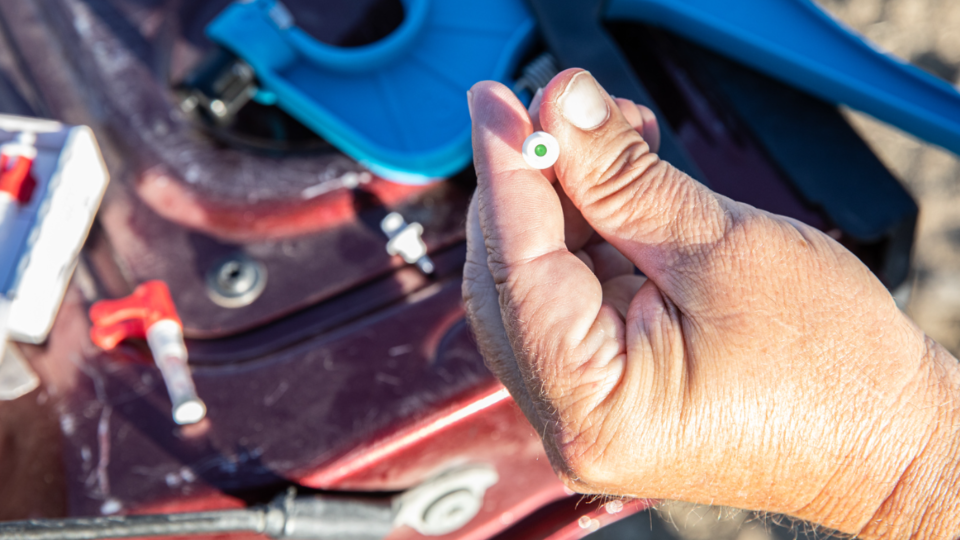Easy, convenient tissue sampling improves herd genetics animal by animal
DNA testing is a management practice increasingly being embraced by seedstock and commercial cow-calf producers as they accelerate the adoption of genetic traits to optimize performance specific to their ranches.
Tom Brink, CEO of the Red Angus Association of America, says Red Angus producers are more actively using DNA testing every year. “They understand the importance of parent verification and accurate pedigrees. Plus, they appreciate the increased EPD accuracy that comes from genotyping their cattle.”
“The best bang for the genomic dollar will be on those replacement female candidates,” Brink continues, and he outlines a typical approach.
The first decision is how the DNA sample is going to be collected. Blood and hair are options, but the most convenient method tends to be sampling using Allflex Tissue Sampling Units (TSUs), which are quick, easy and clean. “They are easier to use,” Brink says. “It’s much like tagging an animal.”

Then, let’s assume a 100-head calf crop and 50 of them are heifers, he says. “I’m going to keep 20 as replacement heifers for my herd,” he says. “What I might do is initially identify 30 candidates as replacements and DNA test all 30. Then use the genomic results along with phenotypic evaluation to decide on the final 20.”
Focus on eliminating the bottom end rather than selecting for the top end, he says. “What’s really going to cost you money are those multi-trait, genetically weak animals.” Those would be the heifers with low scores in the economically important traits you have identified for improvement in your herd.
“You don’t necessarily want the emphasis on the highest scoring heifers, because some of those heifers might end up being too extreme.” Brink cautions. “I find out that by genomically testing replacement heifer candidates that I’ve got a big variation from top to bottom in a single herd,” he says. “I may not necessarily want to keep the extreme top end because those cattle may be a little extreme for what I want.”
Selecting for genetic traits such as growth or milk could, in successive generations, result in larger cows than the farm can handle. “It’s going to be a balanced set of traits; some maternal traits and some terminal traits,” he says.
“If you will repeat that over a period of years,” Brink says, “you’re going to get rid of the bottom end of genetics in your cow herd, or go a long way in that direction, which is really going to help the productivity of the herd.”
Leoma Wells, owner and founder of Data Genie, LLC., calls herself a data accountant. She helps her customers integrate data from multiple sources into the farm record-keeping system. Allflex TSUs are being used by increasing numbers of commercial beef producers in her client base to obtain, analyze and improve herd genomics. She outlines three reasons for their increased popularity.
First, data gathered from Allflex TSUs reinforce and refine visual selections producers are making for animals with desired traits. While appearing very similar, heifers can have wide genetic variations based on traits passed on by parents.
A second factor relates to consistent, extended herd productivity. “For replacement females, the ability to have a snapshot of that female’s genetic potential leads to increased confidence in keeping that heifer. You can say, ‘This heifer is more likely to be here until age six or seven by looking at her stayability metrics,’” Wells said.
And third, while replacement heifers are a main driver of the adoption for many of her clients, there can be an add-on benefit for steer profitability. “On average, your steers will have similar genetics to your heifers. That information may add to their sale price,” she says.
Jim Butcher, a Simmental seedstock producer from Lewistown, Montana, is all in on DNA testing. “The sky’s the limit if you have that sample,” he says.
Each TSU DNA sample reveals genomic information that can, in aggregate and by animal, help more quickly advance a herd’s genetic progress in an intentional, science-assisted direction.
And it’s not just the females. Bulls can be full siblings and still vary widely in their genetic makeup. “We’re great phenotype collectors of birth weights, weaning weights, all that,” says Butcher. “But you really don’t know what you have until you know what genes that particular animal picked up.”
The genetic data generated from an Allflex TSU is used to create genomically enhanced EPDs for seedstock producers, Butcher says. Analyzing the enhanced EPDs provides him and his customers with more accurate insights into the potential of young bulls and their potential fit on a ranch. “You lessen the probabilities that you’re buying an animal that won’t help you move your program forward,” Butcher says.
Find more content for your beef operation.
